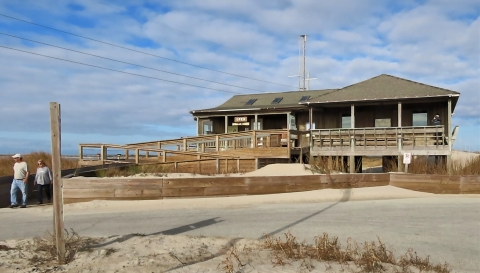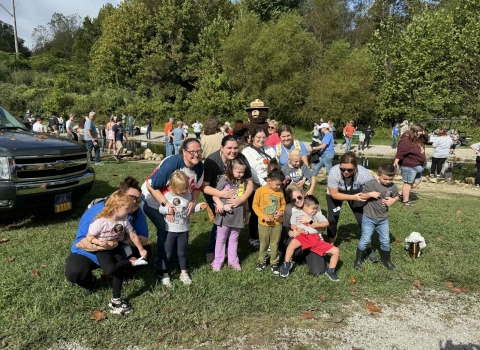Rodanthe, North Carolina – Five feet worth of forethought should save a mile of misery for Pea Island National Wildlife Refuge.
That’s the height from the ground that the North Carolina refuge’s visitor center has been raised. By lifting the building, the U.S. Fish and Wildlife Service (Service) effectively raised the odds that the center will survive flooding and related extreme-weather events that have become all too commonplace with climate change climate change
Climate change includes both global warming driven by human-induced emissions of greenhouse gases and the resulting large-scale shifts in weather patterns. Though there have been previous periods of climatic change, since the mid-20th century humans have had an unprecedented impact on Earth's climate system and caused change on a global scale.
Learn more about climate change .
Late last year, refuge staff and others celebrated the building’s new elevation with a ribbon-cutting recognizing the fund-raising that paid for jacking the building a little higher from harm’s way. Shannon Estenoz, the Department of the Interior’s Assistant Secretary for Fish and Wildlife and Parks, attended the ceremony.
“Climate change poses historic challenges, and this kind of innovative thinking and planning for the future is emblematic of the work of the Service and its partners,” she said. “Projects like this illustrate the benefits we can anticipate from the Bipartisan Infrastructure Law Bipartisan Infrastructure Law
The Bipartisan Infrastructure Law (BIL) is a once-in-a-generation investment in the nation’s infrastructure and economic competitiveness. We were directly appropriated $455 million over five years in BIL funds for programs related to the President’s America the Beautiful initiative.
Learn more about Bipartisan Infrastructure Law , a once-in-a-generation investment in the resilience of physical and natural systems in American history.” The Coastal Wildlife Refuge Society, a nonprofit whose mission is to support coastal refuges in North Carolina, headed the fund-raising. The society collected $25,000 for the project, which involved a house-moving company as well as a contractor that drove piles into the ground. It began in early 2020 and wrapped up a few months later. The Service delayed a ribbon-cutting for the project for more than a year due to COVID-19 impacts.
The product of all that work is tangible proof that the Service and its partners are following the Biden administration’s lead in preparing for climate change, said Brett Hunter, Deputy Regional Chief of Refuges for the Service’s southeastern region, which includes Pea Island NWR.
“We in the Service recognize the importance of collaboration and partnerships,” he said. “Look at what this strong partnership has accomplished at the visitor center – it has bought us more time to meet our visitors at this beloved refuge.”
The center, built in 1995, is a popular stop at the refuge, which sees more than 2 million visitors a year. It sells souvenirs and gifts, as well as contains information about Pea Island. The refuge, 13 miles long and comprising 5,834 acres, is located on the north end of Hatteras Island on the Outer Banks. Founded in 1938, it is one of 568 refuges across the country and U.S. territories. For more information, see: https://www.fws.gov/refuge/pea_island/.





